https://doi.org/10.14482/inde.42.02.089.456
Properties of a High Performance Concrete manufactured with a conventional production process
Propiedades de un hormigón de alto desempeño fabricado con un proceso de producción convencional
Andrés Felipe Restrepo Ramírez*
Simón López Sánchez**
César Echavarría ***
Correspondencia: César Echavarría: Universidad Nacional de Colombia. Carrera 65 59A-110, Bloque 24, Medellín, Colombia. Teléfono: 6044309421. caechavarrial@unal.edu.co.
Subvenciones: Universidad Nacional de Colombia, sede Medellín, Facultad de Arquitectura.
Abstract
Among cement-based composites, materials that show a growing interest are the High Performance Concrete (HPC) and Ultra-high Performance Concrete (UHPC), which are categorized by an effective screening of granular elements, and an elevated quantity of fiber reinforcement [1]. HPC is produced through the particle packing methodology to enhance its matrix density and reduce its porosity [2]. Because of this producing method, this material has a lower water content than conventional concrete, and better mechanical performance and durability [3H5]. It is thus suitable to build several structural elements [6], [7] thanks to its enhanced properties. On the other hand, the manufacture of HPC is not straightforward: expensive raw materials, impact on the environment, laborious fabrication and curing tasks [8], [9] are among the most important obstacles to its large-scale use. It is therefore relevant and recommended to simplify its production process. This work present new HPC mixtures that are produced in a straightforward manner, without requiring elevated temperature curing conditions, mixers with high power or temperature controlled chambers, as commonly used for current HPC sold in the market. The mixtures described here showed a split tensile strength of 5 MPa, a compressive strength of over 70 MPa, and a virtual packing density of 0.86.
Keywords: general purpose Portland cement, high strength, mixing procedure, spherical particles of steel, ultrafine, virtual packing density.
Resumen
El hormigón de alto desempeño (HPC) y de ultra alto desempeño (UHPC) son compuestos a base de cemento con una gradación optimizada de componentes y un alto porcentaje de refuerzo interno discontinuo de fibras [1]. La mezcla de HPC se formula utilizando un modelo de empaquetamiento de partículas para optimizar la densidad de la matriz y minimizar los vacíos [2]. Gracias a su bajo contenido de agua en comparación con el hormigón convencional, el HPC presenta un mejor rendimiento mecánico y mayor durabilidad [3H5]. Por lo tanto, hay más flexibilidad para utilizar el HPC en una gama más amplia de elementos estructurales [6], [7]. A pesar del alto rendimiento mecánico de este tipo de hormigón, existen algunas barreras para la fabricación del HPC: alto costo de los materiales, impacto ambiental, procesos complejos de fabricación y curado [8], [9]. Es entonces importante simplificar su proceso de producción. Entre las diferentes mezclas de HPC propuestas en esta investigación, se estimó una resistencia a la tracción de 5 MPa, una resistencia a la compresión superior a 70 MPa y una densidad virtual de empaquetamiento de 0.86. A diferencia de los HPC actualmente comercializados, el HPC estudiado aquí no requiere regímenes especiales de curado a alta temperatura, mezcladoras de alta intensidad o cámaras con temperatura controlada.
Palabras clave: alta resistencia, cemento Portland de uso general, densidad virtual de empaquetamiento, partículas esféricas de acero, proceso de mezclado, ultrafino.
Fecha de recepción: 29 de marzo de 2023
Fecha de aceptación: 12 de enero de 2024
INTRODUCTION
Ultra-high Performance Concrete (UHPC) is a composite material constituted by an improved gradation of components, a proportion between water and cementitious materials lower than 0.25, and a relevant quantity of reinforcement. Among its mechanical properties, it is worth highlighting a compressive strength greater than 150 MPa, as well as a tensile strength greater than 5 MPa [1].
In the tensile behavior of UHPC, the strength provided by the fiber reinforcement is greater than the cementitious matrix cracking strength [10]. There is however a huge disparity between compressive and tensile UHPC's strengths. In particular, High performance concrete (HPC) has interested engineers during last decades due to its unique properties allowing high durability and high tensile and compressive strengths [11], [12]. The compressive and tensile strengths of HPC are less unbalanced. Early versions of HPC, whose compressive strength exceeds 50 MPa [1], were based on the concept of homogeneity of the concrete matrix taken from Densified Small Particles Concrete (DSP) and Reactive Powder Concrete (RPC) studies [9]. The use of ultrafine aggregates (e.g. silica fume, fly ash, etc.) to optimize the packing density [11], [13], [14] or the use of coarse aggregates to decrease manufacturing costs is usual [15]. In fact, high compressive strength and low porosity of the concrete are the result of two main principles: packing optimization of the material particles [16]-[18], and low water to binder ratios (w/b) [2], [11]. Otherwise, specialized manufacturing and curing methods to produce HPC are frequently required [11], [15]. HPC is a concrete suitable for highway infrastructure repair and replacement [10], the fabrication of precast and prestressed elements for bridges [1], [3] and urban furniture [19], [20]. In the future, HPC precast elements will play an important role in the field of civil engineering [21], [22]. Although it is a material with high performance, its manufacturing is not straightforward because of its high cost, as well as the complexity of the production method and curing. HPC mixing will require equipment that provides more energy than for conventional concrete because the particles in HPC mixes are smaller and the water to cement ratios are low [23]. Insufficient mixing energy can result in inappropriate distribution throughout the mix when ultrafine particles are used, which is detrimental to the HPC performance. It is important to clarify that a particle is defined as fine if its diameter is shorter than 125 |im, while it is ultrafine if it is less than 5 |im. Ultrafine particles (metakaolin, rice husk ash, copper slag, colloidal nano-silica, pulverized fly ash, eggshell powder, tire rubber powder, pulverized granulated blast furnace slag, silica fume, etc.) are normally used in HPC to increase mechanical properties. Among the materials employed to produce HPC, silica fume is the frequently used. However, it is characterized by high surface, like other ultrafine materials, and absorb more water, leading to a decrease the workability of HPC
[24]. The latter also increases HPC manufacturing costs, as higher mixing speeds and longer mixing times would be required. In effect, manufacturing HPC may require special mixing techniques and the application of heat, steam, or pressure treatment before and during setting [12], [15], [23], [25]. In addition, these methods require expensive facilities and is sometimes difficult to apply to full size elements like beams or slabs [16], [19]. Therefore, large-scale HPC production is not attractive to industry, limiting its use [26], [27]. The production method is a crucial step in the preparation of any type of concrete, but it is still more relevant when the mechanical properties must be enhanced, such as in HPC. It is worth mentioning here that sometimes when producing and analyzing small quantities of HPC in the laboratory for research purposes, equipment with high speed and long mixing time is used. These conditions clearly differ from the production of an industrial concrete. The objective of the manufacturing method should be thus twofold: ensuring high quality standards and employing simple fabrication steps, without the requirement of specialized and costly materials and curing regimes [23], [28]. Several authors, such as Mohd Zahid et al. [15], [25], Shi et al. [26] and Sobuz et al. [23], indicated that the economic analysis of fabrication of HPC has been little studied so far, highlighting the importance of the study presented here.
For these reasons, it is desirable to consider a simple production method of HPC. Therefore, this work focuses on the manufacture of HPC with techniques and tools commonly applied to standard concrete. Here, 3 HPC mix designs were analyzed, and 23 cylindric concrete samples (100 mm x 200 mm) were tested for each of them to study the correlation between the main parameters of interest (strengths, water to binder proportion, and matrix packing density).
MATERIALS AND METHODS
Three mix designs of HPC were considered and at least 23 cylindrical concrete specimens (100 mm x 200 mm) were manufactured for each mix (see Table 1). Most researchers suggest using a specialized Type ii/iii cementitious material [15], [29], [30]. In contrast, to fabricate HPC mixes in this research, a standardized general purpose cement or Type I with a density of 3150 kgf/m3 (ASTM C1157 [4]) was used. At present, cement Type I could cost 25 percent less than cement Type iii. To produce the HPC mixes, fine aggregate was also used, standardized under ASTM C136 [5], with a maximum particle size of 1.18 mm, a fineness modulus of 1.9 and a density of 2600 kgf/m3 (see Figure 1); a micro silica powder with a density of 2300 kgf/m3 was also used (see Figure 2); a High Range Powder Water Reducer (HRWR) was included (0.3 % by weight of the cement) and spherical particles of steel with a diameter smaller than 2.36 mm with a density of 7000 kgf/m3 were used (see Figure 3). For comparison purposes, polypropylene microfibres with a length of 19 mm, a density of 910 kgf/m3 and a tensile strength of 300 MPa were used (see Figure 4). The target slump of HPC mixtures is 100 mm. No coarse aggregates were used in any mix.
The conventional economic production process used in this research and summarized below is to ensure fluidisation of dry constituents with a mixture of water and HRWR to prepare HPC with better mechanical behavior. First, 50 % of all dry materials, fine aggregate, micro silica powder and cement, are placed in a low speed mixer (drum or planetary mixer) for about two minutes. Then, the water and HRWR are blended, gradually adding the 50 % of it to the dry constituents and stirring at once for about four minutes. Premixing the water and HRWR aids in more uniformly distributing the HRWR. Next, the other 50 % of all dry materials are gradually added and mixed for about four minutes. Finally, the remaining water HRWR mixture and eventually the spherical particles of steel and polypropylene microfibres are combined for about two minutes until the constituents are thoroughly merged and wetted.
Cylindrical specimens were mould for each mix. For each mix design, compressive strength, tensile strength, permeability, and density were determined.
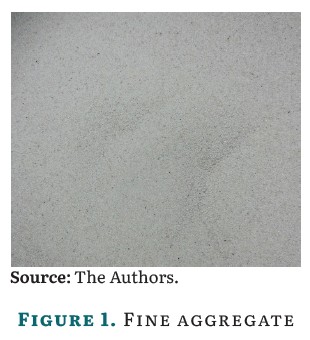
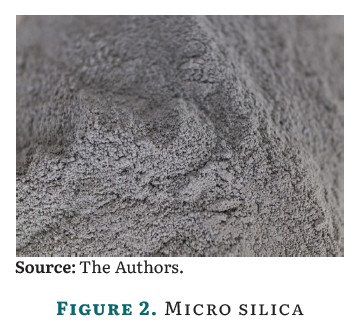
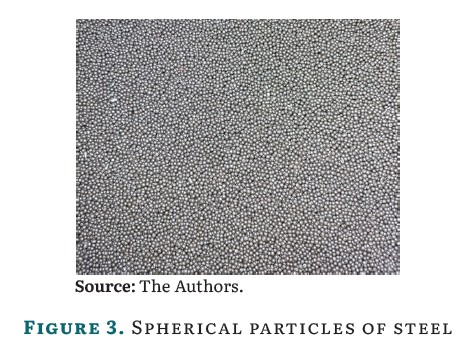
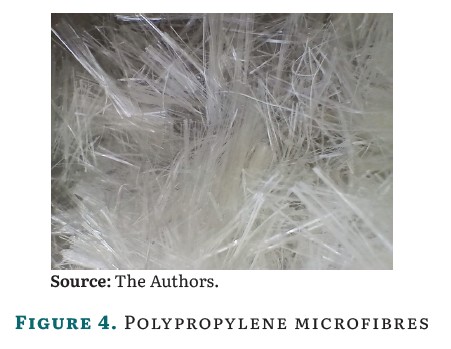
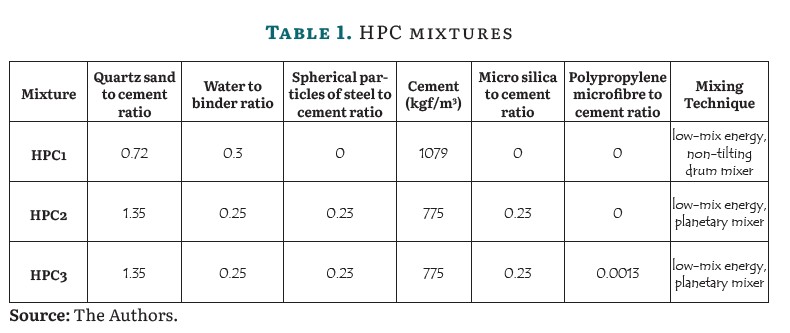
Mixture HPC1, with just cement and fine aggregate (quartz sand), was intended to attain a compressive strength greater than 50 MPa. Evidently, the amount of cement used in this sample is considerable. In HPC2 and HPC3, the cement and water are reduced, and the quantity of fine aggregate is optimized to reach a compressive strength greater than 70 MPa. Steel particles were added to increase the compressive strength while leaving constant the amount of cement. For comparative purposes, polypropylene microfibres were added in HPC3 mixture. The specimens were removed from curing tank, dried, and tested. Permeability tests were performed evaluating the end faces of the concrete specimens, according to SIA 262/1 [31] (see Figure 5).
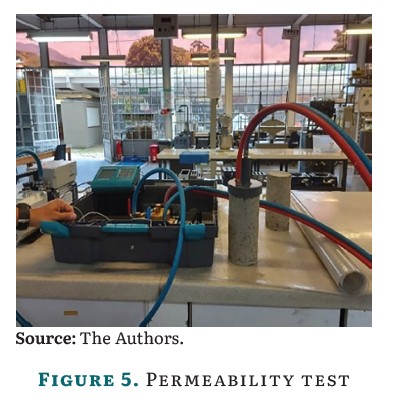
Thirty cylindrical concrete specimens of each mixture were analyzed and tested after 28 days of curing to estimate their compressive strength (see Figure 6), and the ASTM C39 [6] Standard was fulfilled.
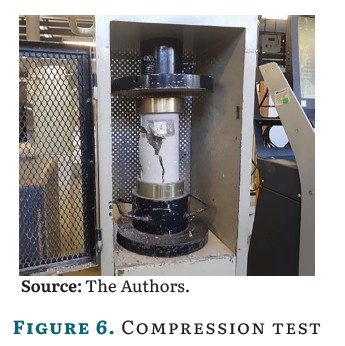
Ten cylindrical concrete specimens of each mixture were tested according to ASTM C496 [7] (see Figure 7).
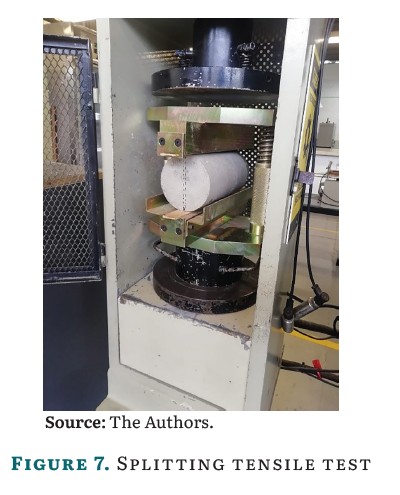
The density of hardened concrete according to ASTM C642 [8] was determined for all cylindrical concrete specimens.
RESULTS AND DISCUSSION
The average permeability coefficient (kT) of the samples was estimated (see Table 2). This coefficient allows measuring the ease with which small particles (e.g. chloride ions) can penetrate the matrix of the HPC. All tested HPC specimens have low permeability compared to conventional concretes whose permeability coefficients ranging from 0.70 to 3 [32]. This is due to the low water to cement ratio and optimized packing system of the specimens manufactured in this research.
The 28-day average compressive strength of the cylindrical HPC specimens was determined (see Table 2). The different HPC mixtures developed in this investigation obtained strengths above 50 MPa. These values are comparable with those obtained in other high performance concretes containing ultrafine particles [11], [13], [14] or whose aggregates were partially substituted by other types of materials [33], [34] (see Table 3). For all different mixes in this investigation, substantial improvements in compressive strength were obtained, since the packing system was optimized by using only fine aggregates of small grain size. The virtual packing density (VPD) represents the maximum potential packing density of a mixture (De Larrard [16]). This model predicts the properties of a mixture using the size distribution and packing density of each monogranular constituent in the concrete mix. The equation describing the VPD of a granular mix containing n particles classes is presented by Eq. (1) (De Larrard [16]):
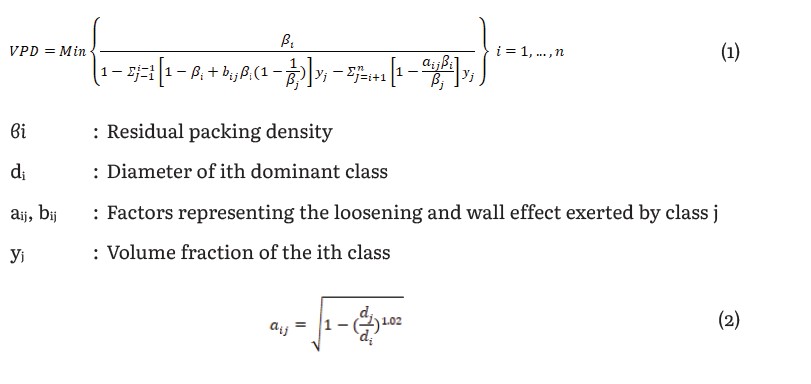

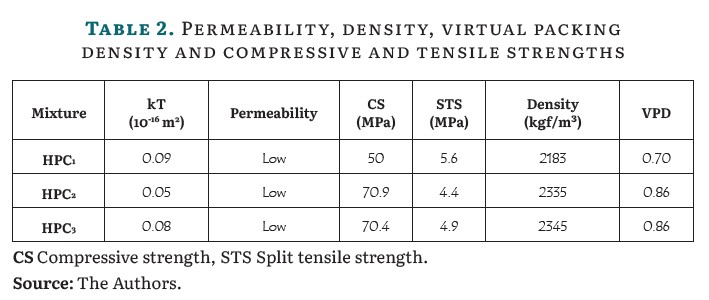
The 28-day average split tensile strength of cylindrical HPC specimens was determined (see Table 2). The specimens developed in this research have performed identical to high performance concretes found in the literature (see Table 3).
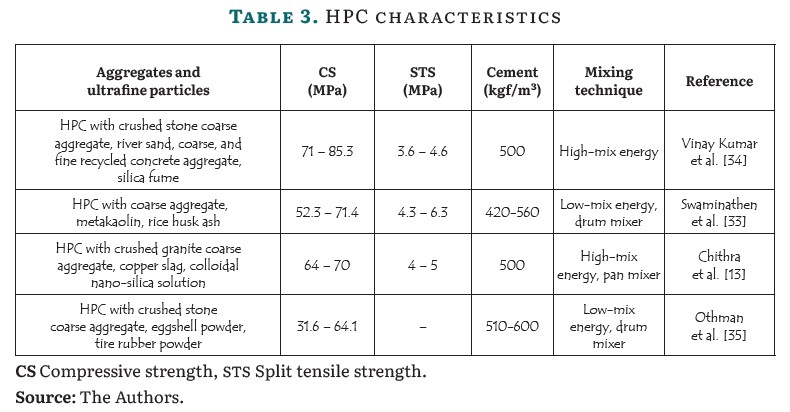
By using fine aggregates with smaller sizes than usual, the packing system was optimized (see Figure 8 and Figure 9), demonstrated by the fact that adequate VPD associated with high compressive strengths and low permeability coefficients were achieved (see Table 2). While it is true that smaller particles increase the fluidity of the mixes, they do not necessarily reduce the final strength of the concrete. The optimum mixture is HPC2 because it has a high compressive strength and an adequate density. HPC1 shows the highest tensile strength, although it has a very high amount of cement, which makes the concrete element expensive.
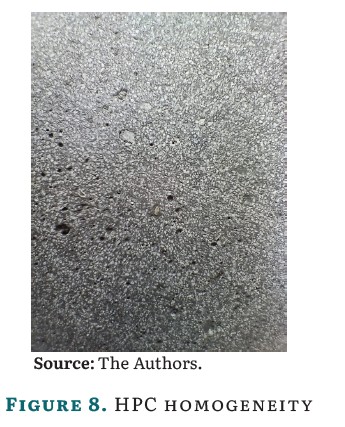
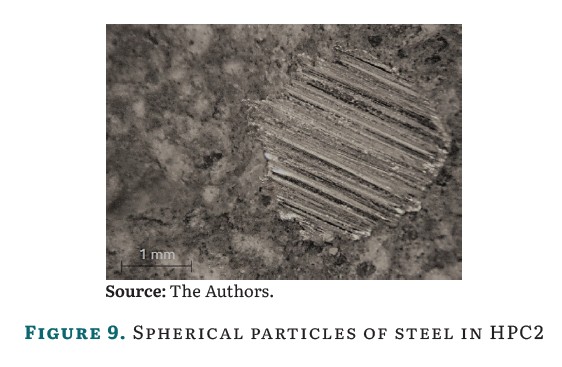
CONCLUSIONS
This research studies the fabrication of HPC, without coarse aggregate, with easily available resources, with simple fabrication and curing procedures, achieving indirect tensile and compressive strengths similar to the HPC produced at present time.
HPC mixes are fabricated using a particle packing design approach to improve the matrix density and reduce the porosity.
It would be believed that the durability of the HPC manufactured in this research is superior to that of conventional concrete, since the permeability coefficients are considerably lower. At the same time, it should increase its lifespan and reduce maintenance costs.
The use of a general purpose or Type I cement and a very small amount of HRWR, which improves the workability of the mix, reduces the production costs of this HPC. This is a significant result since the cementitious materials and superplasticizers used in currently commercialized high-performance concretes are high-priced.
The manufacturing techniques and instruments used here are the same as those used in the fabrication of conventional concretes. A common low speed mixer was used. According to the experience gained in this work, it is possible to state that the production of HP mix can be scaled up and applied in the construction industry; it does not require special curing regimes at high temperatures, nor high speed concrete mixing machines, nor wet chambers, as is required for currently commercialized high performance concretes.
In future research, we will try to increase the tensile strength of HPC to have a material with much more balanced mechanical properties. The long-term performance of this HPC will be investigated in a future study too.
* Docente Ocasional, Universidad Nacional de Colombia. Facultad de Arquitectura, Escuela de Construcción, Medellín (Colombia) Arquitecto constructor. Orcid ID: https://orcid.org/0000-0002-1178-7780. anfrestrepora@unal.edu.co.
** Estudiante, Universidad Nacional de Colombia. Facultad de Arquitectura, Escuela de Construcción, Medellín (Colombia). Estudiante del pregrado de construcción. Orcid ID: https://orcid.org/0009-0003-7383-9261. silopezs@unal.edu.co.
*** Profesor, Universidad Nacional de Colombia. Facultad de Arquitectura, Escuela de Construcción, Medellín (Colombia). PhD ès Sciences. Orcid ID: https://orcid.org/0000-0002-2885-1945. caechavarrial@unal.edu.co.
REFERENCES
[1] A. Aguado, L. Agulló, R. Gettu, and A. Josa, "Los hormigones de altas prestaciones en las infraestructuras viarias," Cemento Hormigón, vol. 813, n°. August, pp. 742-754, 2000.
[2] P.C. Aïtcin, "The importance of the water-cement and water-binder ratios," Science and Technology of Concrete Admixtures, pp. 3-13, 2016. https://doi.org/10.1016/B978-0-08-100693-1.00001-1.
[3] A.K. Akhnoukh, "Accelerated bridge construction projects using high performance concrete," Case Studies in Construction Materials, Volume 12, 2020. https://doi.org/10.1016/j.cscm.2019.e00313.
[4] ASTM International, ASTM C1157 / Cii57M-20a, Standard performance specification for hydraulic cement. West Conshohocken, PA, 2020. https://doi.org/10.1520/C1157_C1157M-17.
[5] ASTM International, ASTM C136 / C136M-19, Standard test method for sieve analysis of fine and coarse aggregates. West Conshohocken, PA, 2019. https://doi.org/10.1520/C0136_C0136M-19.
[6] ASTM International, ASTM C39 / C39M-21, Standard test method for compressive strength of cylindrical concrete specimens. West Conshohocken, PA, 2021. https://doi.org/10.1520/C0039_C0039M-21.
[7] ASTM International, ASTM C496 / C496M-17, Standard test method for splitting tensile strength of cylindrical concrete specimens. West Conshohocken, PA, 2017. https://doi.org/10.1520/C0496_C0496M-17.
[8] ASTM International, ASTM C642 / C642-13, Standard test method for density, absorption, and voids in hardened concrete. West Conshohocken, PA, 2013. https://doi.org/10.1520/C0642-13.
[9] H. H. Bache, "Densified cement ultra-fine particle-based materials," Proceedings of the 2nd International Conference on Superplasticizers in Concrete, Ottawa, June, pp. 33,1981.
[10] B. Graybeal, "Ultra-high performance concrete, Technical note," fhwa-hrt-11-038, Federal Highway Administration, McLean, VA, pp. 1-8, 2011.
[11] M.A. Bajaber, and I.Y. Hakeem, "UHPC evolution, development, and utilization in construction: A review," Journal of Materials Research and Technology, vol. 10, pp. 1058-1074, 2021. https://doi.org/10.1016/j.jmrt.2020.12.051.
[12] S. El-Tawil, Y.-S. Tai, B. Meng, W. Hansen, and Z. Liu, "Commercial production of non-proprietary ultra-high performance concrete," Report No. rc-1670, Michigan Department of Transportation, Michigan, 2018.
[13] S. Chithra, S.R.R. Senthil Kumar, and K. Chinnaraju, "The effect of colloidal nano-sil-ica on workability, mechanical and durability properties of high performance concrete with copper slag as partial fine aggregate," Construction and Building Materials, vol. 113, pp. 794-804, 2016. https://doi.org/10.1016/j.conbuildmat.2016.03.119.
[14] J. Yajun and J.H. Cahyadi, "Effects of densified silica fume on microstructure and compressive strength of blended cement pastes," Cement and Concrete Research, vol. 33, no. 10, pp. 1543-1548, 2003. https://doi.org/10.1016/S0008-8846(03)00100-5.
[15] M.Z.A Mohd Zahid, B.H. Abu Bakar, F.M. Nazri, and M.A.Ab. Rahim, "A review on raw materials and curing methods applied in production of ultra-high performance concrete," IOPConference Series: Materials Science and Engineering, vol. 864, n°. 1, 2020. https://doi.org/10.1088/1757-899X/864/1/012202.
[16] F. de Larrard and T. Sedran, "Optimization of ultra-high-performance concrete by the use of a packing model," Cement and Concrete Research, vol. 24, n°. 6, pp. 997-1009, 1994. https://doi.org/10.1016/0008-8846(94)90022-1.
[17] O. Mishra and S.P. Singh, "An overview of microstructural and material properties of ultra-high-performance concrete," Journal of Sustainable Cement-Based Materials, vol. 8, n°. 2, pp. 97-143, 2019. https://doi.org/10.1080/21650373.2018.1564398.
[18] K. Wille, A.E. Naaman, and S. El-Tawil, "Optimizing ultra-high-performance fiber-reinforced concrete," Concrete international, September 2011, pp. 35-41, 2011.
[19] M. Kleiner, M. Curbach, A.E. Tekkaya, R. Ritter, K. Speck, and M. Trompeter, "Development of ultra high performance concrete dies for sheet metal hydroforming," Production Engineering Research and Development, vol. 2, n°. 2, pp. 201-208, 2008. https://doi.org/10.1007/s11740-008-0099-z.
[20] S. Wang and D.W. Halpin, "Simulation experiment for improving construction processes," Proceedings of the 2004 Winter Simulation Conference, vol.2, pp. 1252-1259, 2004. doi: 10.1109/WSC.2004.1371457.
[21] M. Olipitz, "A universal UHPC shell element for consideration of future building with precast elements," in 20th Congress of IABSE 2019: The Evolving Metropolis New York 2019, IABSE Symposium Report Volume 114, pp. 2271-2280, 2019.
[22] V.H. Perry and M. Royce, "Innovative field-cast UHPC joints for precast bridge decks (side-by-side deck bulb-tees), Village of Lyons, New York: Design, prototyping, testing and construction," in 3rd fib International Congress, pp. 1-13, 2010, Washington, D.C., USA.
[23] H.R. Sobuz, P. Visintin, M.S. Mohamed Ali, M. Singh, M.C. Griffith, and A.H. Sheikh, "Manufacturing ultra-high performance concrete utilising conventional materials and production methods," Construction and Building Materials, vol. 111, pp. 251-261, 2016. https://doi.org/10.1016/j.conbuildmat.2016.02.102.
[24] Z. Wu, C. Shi, and K.H. Khayat, "Influence of silica fume content on microstructure development and bond to steel fiber in ultra-high strength cement-based materials (UHSC)," Cement and Concrete Composites, vol. 71, pp. 97-109, 2016. https://doi.org/10.1016/j.cemconcomp.2016.05.005.
[25] M.Z.A. Mohd Zahid, B.H. Abu Bakar, F.M. Nazri, A. Ayob, and R.A. Razak, "Manufacturing of cast in situ ultra high performance fibre reinforced concrete (UHPFRC) - Workability, tensile and compressive strength," IOP Conference Series: Materials Science and Engineering, vol. 743, n°. 1, 2020. https://doi.org/10.1088/1757-899X/743/1/012028.
[26] C. Shi, Z. Wu, J. Xiao, D.Wang, Z. Huang, and Z. Fang, "A review on ultra high performance concrete: Part I. raw materials and mixture design," Construction and Building Materials, vol. 101, pp. 741-751, 2015. https://doi.org/10.1016/j.conbuildmat.2015.10.088.
[27] S. Vatannia, E. Kearsley, and D. Mostert, "Development of economic, practical and green ultra-high performance fiber reinforced concrete verified by particle packing model," Case Studies in Construction Materials, vol. 13, pp. 1-16, 2020. https://doi.org/10.1016/j.cscm.2020.e00415.
[28] J. Liu, C. Shi, X. Ma, K.H. Khayat, J. Zhang, and D. Wang, "An overview on the effect of internal curing on shrinkage of high performance cement-based materials," Construction and Building Materials, vol. 146, pp. 702-712, 2017. https://doi.org/10.1016/j.conbuildmat.2017.04.154.
[29] G. Choe, K. Gyuyong, G. Gucunski, and L. Seonghun, "Evaluation of the mechanical properties of 200 MPa ultra high strength concrete at elevated temperatures and residual strength of column," Construction and Building Materials, vol. 86, pp. 159-168, 2015. https://doi.org/10.1016/j.conbuildmat.2015.03.074.
[30] C. Kahanji, F. Ali, A. Nadjai, and N. Alam, "Effect of curing temperature on the behaviour of UHPFRC at elevated temperatures," Construction and Building Materials, vol. 182, pp. 670-681, 2018. https://doi.org/10.1016/j.conbuildmat.2018.06.163.
[31] Norme Suisse SIA 262/1, "Construction en béton - Spécifications complémentaires - Annexe E: Perméabilité à l'air dans les structures," Swiss Society of Engineers and Architects, pp. 30-331, Zurich, 2003.
[32] M.H. Nguyen, K. Nakarai, and R. Torrent, "Service life prediction of steam-cured concrete utilizing in-situ air permeability measurements," Cement and Concrete Composites, vol. 114, 2020, 103747. https://doi.org/10.1016/j.cemconcomp.2020.103747.
[33] A.N. Swaminathen, C. Vivek Kumar, S. Robert Ravi, and S. Debnath, "Evaluation of strength and durability assessment for the impact of rice husk ash and metakaolin at high performance concrete mixes," Materials Today: Proceedings, vol. 47, pp. 4584-4591, 2021. https://doi.org/10.1016/j.matpr.2021.05.449.
[34] B.M. Vinay Kumar, H. Ananthan, and K.V.A. Balaji, "Experimental studies on utilization of recycled coarse and fine aggregates in high performance concrete mixes," Alexandria Engineering Journal, vol. 57, n°. 3, pp. 1749-1759, 2018. https://doi.org/10.1016/j.aej.2017.05.003.
[35] R. Othman, B.W. Chong, R.P. Jaya, M.R.M. Hasan, M.M.A.B. Abdullah, and M.H.W. Ibrahim, "Evaluation on the rheological and mechanical properties of concrete incorporating eggshell with tire powder," Journal of Materials Research and Technology, vol. 14, pp. 439-451, 2021. https://doi.org/10.1016/j.jmrt.2021.06.078.